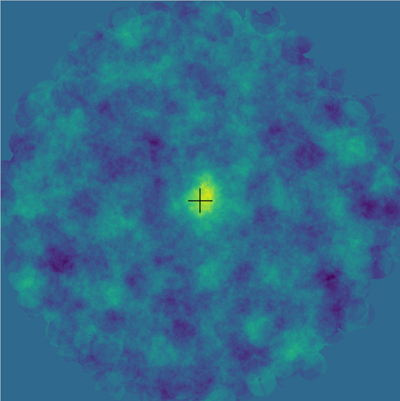Campus News
Detection of Crab Nebula shows viability of innovative gamma-ray telescope
A new prototype telescope opens doors for future discoveries at the upcoming Cherenkov Telescope Array.


Scientists in the Cherenkov Telescope Array (CTA) consortium have detected gamma rays from the Crab Nebula using a prototype Schwarzschild-Couder Telescope (pSCT), proving the viability of the novel telescope design for use in gamma-ray astrophysics. The results were announced June 1 at the 236th meeting of the American Astronomical Society (AAS).
“For fifty years, the optical design of gamma-ray telescopes has been essentially unchanged. With this detection, we have verified a new, more sophisticated optical design that not only gives enormously better optical performance, but enables the camera to take full advantage of modern developments in light sensors and high-speed electronics,” said David Williams, a researcher in the Santa Cruz Institute for Particle Physics (SCIPP) and adjunct professor of physics at UC Santa Cruz.
Williams is a co-principal investigator on the grant from the National Science Foundation that supported construction of the telescope. His group at UCSC, including several undergraduate students, tested light sensors to select the best model to use in the telescope camera and to calibrate the performance of the sensors purchased for the camera.
The Crab Nebula is the brightest steady source of very-high-energy gamma rays in the sky, so detecting it is an excellent way of proving the pSCT technology. “Very-high-energy gamma rays are the highest energy photons in the universe and can unveil the physics of extreme objects including black holes and possibly dark matter,” said Justin Vandenbroucke of the University of Wisconsin.
Detecting the Crab Nebula with the pSCT is more than just proof-positive for the telescope itself. It lays the groundwork for the future of gamma-ray astrophysics. “We’ve established this new technology, which will measure gamma-rays with extraordinary precision, enabling future discoveries,” said Vandenbroucke. “Gamma-ray astronomy is already at the heart of the new multi-messenger astrophysics, and the SCT technology will make it an even more important player.”
The use of secondary mirrors in gamma-ray telescopes is a leap forward in innovation for the relatively young field of very-high-energy gamma-ray astronomy, which has moved rapidly to the forefront of astrophysics. “Just over three decades ago, TeV gamma rays were first detected in the universe, from the Crab Nebula, on the same mountain where the pSCT sits today,” said Vandenbroucke. “That was a real breakthrough, opening a cosmic window with light that is a trillion times more energetic than we can see with our eyes. Today, we’re using two mirror surfaces instead of one, and state-of-the-art sensors and electronics to study these gamma rays with exquisite resolution.”
The initial pSCT Crab Nebula detection was made possible by leveraging key simultaneous observations with the co-located VERITAS (Very Energetic Radiation Imaging Telescope Array System) observatory. “We have successfully evolved the way gamma-ray astronomy has been done during the past 50 years, enabling studies to be performed in much less time,” said VERITAS Director Wystan Benbow. “Several future programs will particularly benefit, including surveys of the gamma-ray sky, studies of large objects like supernova remnants, and searches for multi-messenger counterparts to astrophysical neutrinos and gravitational wave events.”
Located at the Fred Lawrence Whipple Observatory in Amado, Arizona—the largest field site of the Center for Astrophysics | Harvard & Smithsonian—the pSCT was inaugurated in January 2019 and saw first light the same week. After a year of commissioning work, scientists began observing the Crab Nebula in January 2020, but the project has been underway for more than a decade.
“We first proposed the idea of applying this optical system to TeV gamma-ray astronomy nearly 15 years ago, and my colleagues and I built a team in the US and internationally to prove that this technology could work,” said pSCT principal investigator Vladimir Vassiliev. “What was once a theoretical limit to this technology is now well within our grasp, and continued improvements to the technology and the electronics will further increase our capability to detect gamma rays at resolutions and rates we once only ever dreamed of.”
The pSCT was made possible by the contributions of thirty institutions and five critical industry partners across the United States, Italy, Germany, Japan, and Mexico, and by funding through the U.S National Science Foundation Major Research Instrumentation Program.
“That a prototype of a future facility can yield such a tantalizing result promises great things from the full capability, and exemplifies NSF’s interest in creating new possibilities that can enable a project to attract wide-spread support,” said NSF program manager Nigel Sharp.
Now demonstrated, the pSCT’s current and upcoming innovations will lay the groundwork for use in the future Cherenkov Telescope Array observatory, which will host more than 100 gamma-ray telescopes. “The pSCT, and its innovations, are pathfinding for the future CTA, which will detect gamma-ray sources at around 100 times faster than VERITAS, which is the current state of the art,” said Benbow. “We have demonstrated that this new technology for gamma-ray astronomy unequivocally works. The promise is there for this groundbreaking new observatory, and it opens a tremendous amount of discovery potential.”